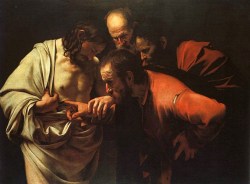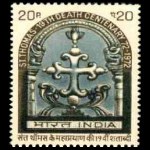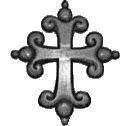Nasrani Cross
Today, there are a few Indian priests in Ireland, yet traditionally, Ireland has sent missionaries to India, even though they do not speak the local languages.
The Church moves in mysterious ways!
The Nasrani Cross is also known as the Nasrani Menorah, the Syrian Cross, the St. Thomas Cross, the Mar Thoma Nasrani and a few other names. It is an ancient symbol, yet loaded with meaning that is still very relevant today.
'Mar Thoma' is Aramaic for 'Saint Thomas' and 'Nasrani' stems from 'Nazareth', the family homeland of Jesus and the site of the Annunciation. We must point out, however, that this cross has no connection with the dubious Nazareth Cross Project. Rather the Nasrani Cross reflects doctrines of the St. Thomas Christians.
Doubting Thomas
Thomas is known for his skepticism of the Resurrection of Jesus Christ. He was a disciple, close follower and friend of Jesus. Yet his real commitment was perhaps just after Jesus was crucified.
The Bible relates (John 20:24-29) that after Jesus was crucified and laid in the tomb, he rose again and appeared to the Apostles, not as a ghost, but actually in the flesh. This was a true resurrection, but Thomas doubted it really was Jesus. He said:
"Except I shall see in his hands the print of the nails, and put my finger into the print of the nails, and thrust my hand into his side, I will not believe."
Jesus later appeared again and said to Thomas:
"Reach hither thy finger, and behold my hands; and reach hither thy hand, and thrust it into my side: and be not faithless, but believing."
Proof enough for Thomas, who replied humbly:
"My Lord and my God."
This episode must have been sufficient to invigorate Thomas to spend the rest of his days spreading the Gospel and carry abroad the parting words of Jesus:
"blessed are they that have not seen, and yet have believed."
The Nasrani
Most Christians in India are Catholic (about 16 million) and crucifixes are popular. But for the Nasrani (about 3 million), their crosses are almost invariably empty, emphasising the resurrection of Christ.
The Apostle Thomas is believed to have been the first to bring Christianity to India, in 52 AD, arriving in Kodungallur, Kerala, where he established Seven Churches. Thomas was a Jew by birth and spoke Aramaic, so his first converts in India were likely the Cochin Jews in southern India. As with many conversions, some of the old practices were mixed with the new, and we see evidence of this at the foot of the Nasrani Cross, where a Jewish Menorah is stylised like a Hindu or Buddhist lotus.
They also retained worship on the Sabbath rather than Sunday, kept Kashrut dietary laws (kosher), segregated men and women in places of worship, used Syriac and Aramaic in liturgies, and so on. Many of these practices continue today.
The 20 Rupee postage stamp (shown left) was released by Governor of Kerala and the head of Syro Malabar Church on 3 July 1973. The stamp shows "St. Thomas death 19th centenary 72-1972"; the year 72 AD being when Thomas was martyred.
He had had a long and fruitful preaching career on the Malabar Coast, converting both immigrant Jews and Hindus.
Local Hindu priests became annoyed at the success of his preaching, as did the civic rulers, who feared this foreign religion would weaken their own power. This is a familiar scenario, repeated several times in the world's history, and the results were equally familiar. It is said that Brahmin killed Thomas by stoning and spearing with a trident, whilst he was praying on a hilltop near Madras.
Doubting Doubting Thomas
Unsurprisingly, this accusation offends Hindus today, who earnestly dispute such an event happened. They point out that there is no concrete historical evidence that Thomas ever visited India, and the whole martyrdom thing was invented by the 16th century Portuguese invaders.
The introduction of the Latin Rite by the Portuguese missionaries further complicated the Hindu / Jewish / Syriac mix. Consider also Jainism, Buddhism, Islam, Sikhism, topped with a layer of the ancient Indian caste system, and further confuddle things with the social and political changes by the various dynasties and empires, the British, the War of Independence, Partition, WWII and wars with its Pakistani and Chinese neighbours (1947, 1962, 1965, 1971 & 1999) culminating in India becoming a nuclear state.
It is little wonder that long ago, the Buddhists quietly slipped out of India through the back door (to China).
And now knocking on the front door, in pairs, wearing smart suits, are the Jehovah's Witnesses who, interestingly, have increased their presence in India, in line with the rise of MLM and the nouveau riche.
But getting back to the doubts over Thomas; both Hindus and Christians agree on the importance of determining an accurate account of what happened in history, yet also agree that contemporary issues are more relevant. True Hindus and true Christians love God, according to their particular tradition and philosophy, and hold that life is sacred. Such love for God cannot be shown by forcing conversion and killing people.
There is no reward in finding fault or shaking anyone's faith. So we'll leave the history for others to argue about and get on with explaining what this Cross means to the Nasrani.
The Emblem
The Nasrani emblem is used by the Syro Malabar Catholic Church (SMCC), the largest group of St. Thomas Christians. The same emblem appears within the logos of several other churches, including the Marthomites' Mar Thoma Syrian Church (MTSC) and the Indian (Malankara) Orthodox Church (IMOC).
Features:
Dove
At the top is a descending dove, representing the Holy Spirit of God, coming down to live in our hearts, enabling us to live a righteous and faithful life.
Buds
Each of the four arms of the cross terminates in a rare form of trefoil. Such budded crosses often feature lilies, most species of which are native to the temperate northern hemisphere. But on the Nasrani Cross, the buds are of the pomegranate, a native plant of north India and common in central Asia.
Whatever the plant may be, however, the symbolism of the buds is 'new life'; the resurrection of Jesus Christ and by extension, the new spiritual life we can all claim, because of Christ's sacrifice.
The four main buds at the arm ends correspond to the four Evangelists. The eight curled leaves at the arm ends represent regeneration (see Baptismal Cross). These four-plus-eight extremities together correspond to the twelve Apostles of Jesus.
Menorah
At the foot of the cross there appears to be something that may be viewed as a throne, or like the burning bush of the Presbyterian Cross. However, the most common interpretation for this part is a Menorah, a sort of candlestick and ancient symbol of the Hebrews. As with the Jewish menorah, there are branches for seven candles.
There are three branches on either side of the cross with the central branch holding the cross. In the Jewish tradition, the central candle is the main one, from which the other six candles are lit. Many Nasrani subscribe to the theory that 'Nazareth' is derived from the Hebrew noun netser, which means 'branch', in the context of the Messianic prophecy in Isaiah 11:1. This begins:
"And there shall come forth a rod out of the stem of Jesse, and a Branch shall grow out of his roots:" (KJV)For the Indian Orthodox Church, the menorah is stylized as a lotus, an Eastern symbol of holiness, purity, spontaneous generation and divine birth. The lotus is India's national flower and also a common symbol of Buddhism and Hinduism, where an offering made on a lotus leaf is considered to be auspicious. The cross above the lotus represents Christianity established in the land of other religions.
Steps
At the very bottom are the steps of Calvary, representing Faith, based upon Hope, based upon Love (1 Cor. 13:13)
Cross
And finally, the cross itself. With the dove at the top and the steps at the bottom, the image is elongated. But you will notice that the four arms of the cross are roughly the same length (crux quadrata) like the Greek Cross. There is no particular meaning in this feature; the cross is simply stunted for aesthetic reasons. But there is profound symbolism in the cross.
It was on this device that Jesus humbly sacrificed his life, to redeem us (that's you and me) of our sin. (See also the Meaning of the Cross.)









